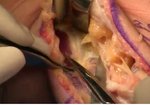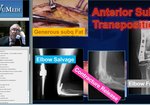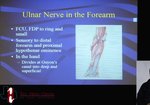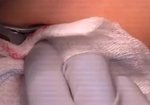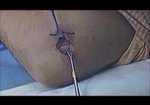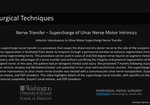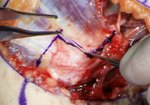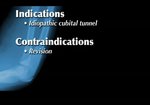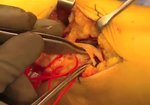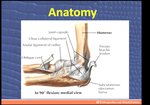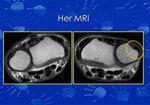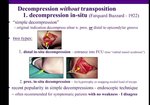Video Player is loading.
Current Time 0:00
/
Duration 0:00
Loaded: 0%
Stream Type LIVE
Remaining Time -0:00
1x
- 0.5x
- 0.75x
- 1x, selected
- 1.25x
- 1.5x
- 1.75x
- 2x
- Chapters
- descriptions off, selected
- captions settings, opens captions settings dialog
- captions off, selected
This is a modal window.
Beginning of dialog window. Escape will cancel and close the window.
End of dialog window.
10 seconds
Playback speed
This is a modal window. This modal can be closed by pressing the Escape key or activating the close button.
Transmuscular Ulnar Nerve Transposition in a Case of Traumatic Medial Cord Injury - Standard
13,842 views
April 10, 2012
<!--Code is buggy. I cannot use <br> or </br> and instead using </strong> for line ...
read more ↘ breaks-->
<strong>High Definition Standard Version - https://vimeo.com/40013470
High Definition Extended Version - https://vimeo.com/40022250
</strong>
<strong>Education Website - http://nervesurgery.wustl.edu
Video Library - https://vimeo.com/user6062882
</strong>
<strong>Transmuscular Ulnar Nerve Transposition in a Case of Traumatic Medial Cord Injury</strong>
Standard Version (10.120405.120328)
</strong>
Cubital tunnel syndrome can present with pain/numbness in the ulnar nerve territory and weakness in the ulnar-innervated extrinsic/intrinsic muscles. The etiology for cubital tunnel syndrome depends on the case and includes various points of compression along the course of the ulnar nerve. The most common compression point is the medial epicondyle at which the fascial leading-edge of the flexor carpi ulnaris and the aponeurosis superficial to the cubital tunnel compress the nerve. However other compressive points can exist and can be under-recognized. The transmuscular ulnar nerve transposition (TUNT) addresses these compressive points by releasing and transposing the nerve through a transmuscular bed within the pronator-flexor muscle bundle. In this case, the patient had a traumatic medial cord injury and presented 1-year following with associated ulnar neuropathy and fibrillations/motor unit potentials. The TUNT was elected with a supercharge anterior interosseous to ulnar motor nerve transfer, Guyon’s canal release, and FDP tenodesis. This video highlights details of the TUNT.
</strong>
Table of Contents
00:15 Orientation / Incision / Exposure
00:40 Identifying the Medial Antebrachial Cutaneous
01:20 Exposing the Medial Epicondyle and Common Flexor Tendon
01:56 Identifying the Ulnar Nerve and Releasing the Cubital Tunnel Aponeurosis
02:12 Creating the Medial and Lateral Fascial Tendon Flaps
03:22 Resecting the Fascial Septum “T” between the Pronator-Flexor Muscle Bundle
04:05 Resecting the Medial Intermuscular Septum
04:49 Resecting the Distal Intermuscular Septum
05:35 Releasing the Aponeurosis of Flexor Carpi Ulnaris and Transverse Vessels
05:50 Releasing the Deep Pronator-Flexor Aponeurosis
06:04 Releasing the Intermuscular Septum
06:48 Neurolyzing the Flexor Carpi Ulnaris Branch from the Ulnar Nerve
07:23 Creating the Transmuscular Bed
07:47 Transmuscular Ulnar Nerve Transposition
09:02 Checking Compression through the Arcade of Struthers
</strong>
Narration: Susan E. Mackinnon
Videography: Andrew Yee
</strong>
Terms of Use and Private Policy: nervesurgery.wustl.edu/pages/termsofuse.aspx
↖ read less
read more ↘ breaks-->
<strong>High Definition Standard Version - https://vimeo.com/40013470
High Definition Extended Version - https://vimeo.com/40022250
</strong>
<strong>Education Website - http://nervesurgery.wustl.edu
Video Library - https://vimeo.com/user6062882
</strong>
<strong>Transmuscular Ulnar Nerve Transposition in a Case of Traumatic Medial Cord Injury</strong>
Standard Version (10.120405.120328)
</strong>
Cubital tunnel syndrome can present with pain/numbness in the ulnar nerve territory and weakness in the ulnar-innervated extrinsic/intrinsic muscles. The etiology for cubital tunnel syndrome depends on the case and includes various points of compression along the course of the ulnar nerve. The most common compression point is the medial epicondyle at which the fascial leading-edge of the flexor carpi ulnaris and the aponeurosis superficial to the cubital tunnel compress the nerve. However other compressive points can exist and can be under-recognized. The transmuscular ulnar nerve transposition (TUNT) addresses these compressive points by releasing and transposing the nerve through a transmuscular bed within the pronator-flexor muscle bundle. In this case, the patient had a traumatic medial cord injury and presented 1-year following with associated ulnar neuropathy and fibrillations/motor unit potentials. The TUNT was elected with a supercharge anterior interosseous to ulnar motor nerve transfer, Guyon’s canal release, and FDP tenodesis. This video highlights details of the TUNT.
</strong>
Table of Contents
00:15 Orientation / Incision / Exposure
00:40 Identifying the Medial Antebrachial Cutaneous
01:20 Exposing the Medial Epicondyle and Common Flexor Tendon
01:56 Identifying the Ulnar Nerve and Releasing the Cubital Tunnel Aponeurosis
02:12 Creating the Medial and Lateral Fascial Tendon Flaps
03:22 Resecting the Fascial Septum “T” between the Pronator-Flexor Muscle Bundle
04:05 Resecting the Medial Intermuscular Septum
04:49 Resecting the Distal Intermuscular Septum
05:35 Releasing the Aponeurosis of Flexor Carpi Ulnaris and Transverse Vessels
05:50 Releasing the Deep Pronator-Flexor Aponeurosis
06:04 Releasing the Intermuscular Septum
06:48 Neurolyzing the Flexor Carpi Ulnaris Branch from the Ulnar Nerve
07:23 Creating the Transmuscular Bed
07:47 Transmuscular Ulnar Nerve Transposition
09:02 Checking Compression through the Arcade of Struthers
</strong>
Narration: Susan E. Mackinnon
Videography: Andrew Yee
</strong>
Terms of Use and Private Policy: nervesurgery.wustl.edu/pages/termsofuse.aspx
↖ read less
Comments 6
Login to view comments.
Click here to Login


